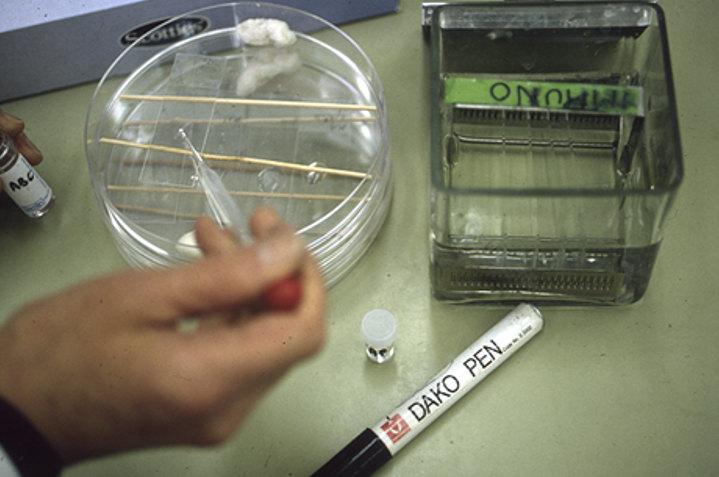This content is also available in:
Čeština
Today many laboratories use automated immunostainers for routine diagnostic immunocytochemistry. Following appropriate fixation (and removal of the PEG layer, if used, in two changes of 95% methanol) the slides are laid in slots in the machine and the preparations are subjected to the various steps in a pre-programmed sequence. Antibodies and their dilution (if not ready to use) are usually prescribed by the supplier of the immunostainer.
In other laboratories the steps must be carried out by hand, placing the preparations in a humid environment such as commercially available plastic or Perspex staining trays. These contain racks on which to lay the slides, an area for water to keep the atmosphere damp and a lid. It is important that the preparations do not dry out during the procedure as this would damage the morphology. However, entirely satisfactory equipment can be as simple as large plastic Petri dishes (14cm diameter) that take four slides. Racks are made by sticking wooden applicator sticks to the bottom of the dish (dip them in Xylene and place on the bottom of the dish), and a ball of damp paper tissue or cotton-wool is placed in the dish with the slides to maintain humidity. The dishes produced by Sterilin (140mm cat.no. 501V) have rims which allow them to be piled vertically, thus saving bench space.

The cell preparation can be isolated by drawing round it with a special pen filled with a waxy substance, leaving a margin round the tissue. This ensures that reagents dropped onto the tissue area will stay in place without running all over the slide, and reduces the need for very careful wiping around it between steps of the method. The pen is most easily applied to a dry area of the slide, but the preparation must remain damp. Many companies provide such pens (eg. Dako delimiting pen S2002, Vector ImmEdge hydrophobic barrier pen, H-4000). The ring dissolves during the final clearing prior to mounting the preparation. It is also desirable to scratch a circle round the cell area on the back of the slide with a diamond pen so that the tissue area is visible after wiping the back of the slide dry between layers.
A useful semi-automated immunostaining apparatus is the Sequenza system (Thermo Scientific 10098889, rack for 10 slides; 11927774, Coverplates, pack of 250). This might be considered expensive initially (though not in relation to an automated machine) but is a worthwhile investment which greatly increases throughput and reduces stress. The coverplates are guaranteed for one use only, but in our experience can be re-used extensively until the spring becomes loose. In this system the slide is placed with the preparation side against a coverplate, held in place by the small protruding pegs, and inserted into an open rack at the angle dictated by the rack. A chamber at the top allows buffer or antibody to be applied to the slide. Buffer fluid (about 5 ml) flows past the preparation, washing it efficiently in 5 minutes as opposed to 15 minutes for the by hand method. Antibody solutions are applied as 100 µl which flows down the slide. 20 µl drips out at the bottom into the collecting space while 80 µl is retained against the slide. The capillary space between the coverplate and the slide allows free movement of molecules so that the antibody can bind to its antigen in the preparation. The slides are not removed from the racks for washing between steps. Care must be taken that all buffer has drained out before application of the next reagent to ensure that this is not diluted in residual buffer.
The isolating pen should not be used with the Sequenza system as it would prevent the free flow of solution past the preparation. A diamond-scratched circle round the preparation on the back of the slide may be helpful when the mounting stage is reached.
Other equipment needed comprises dishes for buffer, racks for slides, a microwave oven (a domestic model is satisfactory), plastic containers and slide racks for use in the oven.

